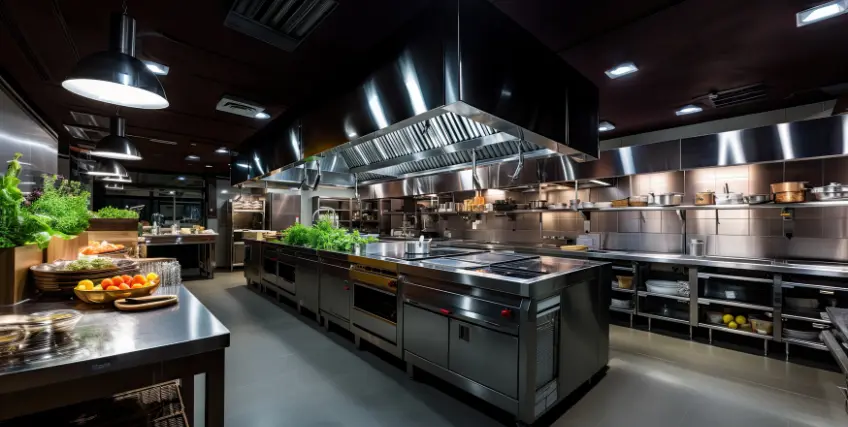Surviving The First Year — A Financial Guide for Restaurant Owners
March 11, 2025 | Last Updated on: March 11, 2025

In this article:
- Starting up: Reality Vs. Expectation
- Financial guidelines for the first 12 months
- Survive in your first year and beyond
- Bridging the gap between small businesses and financing constraints
You've finally taken the bold step to start your restaurant. Congratulations, it's a great milestone!
But don’t expect it to be all roses.
Your equipment might decide to take an unexpected break, renovations could gulp more money than you intended, and let's not forget the usual expenditures that come with running a restaurant.
All of these may seem overwhelming, and you might even be tempted to throw in the towel. But, if you can navigate the hurdles of the first year, you're well on your way to building a thriving restaurant business.
So, how do you make it through the stress of the first 12 months? Let's break it down.
Starting Up: Reality vs. Expectation
One of the first realizations new restaurant owners encounter is the stark contrast between the initial investment and the day-to-day expenses.
You may have meticulously planned and budgeted for the grand opening, but reality often has other plans. Renovations, permits, licenses, and unplanned hiccups can quickly turn your well-thought-out budget into a mere suggestion.
According to CNBC, “restaurant business is not for the faint of heart ... or stomach. They have a high failure rate. Around 60 percent of new restaurants fail within the first year. And nearly 80 percent shutter before their fifth anniversary.”
Hence, the need to arm yourself with success strategies that will preserve your business in the first year.

Financial Guidelines for the First 12 Months
#1. Understand Your Initial Investment
When you decided to open a restaurant, you made an initial investment. This includes everything from securing the location to renovating the space, purchasing equipment, hiring staff, and obtaining licenses.
You may also like: financial plan for restaurant
It’s crucial that you track exactly how much you’ve actually spent (it’s sure to be more than you anticipated).
Use accounting software or hire a professional accountant to keep a detailed record of every penny spent. This will not only help you understand where your money is going but also serve as a reference point for future financial decisions.
#2. Budget for Unexpected Expenses
One of the harsh realities of the restaurant business is that unexpected expenses can and will arise. Equipment breaks down, plumbing issues and unforeseen circumstances can throw a wrench into your well-laid plans.
To handle these challenges successfully, it's essential to create a contingency plan within your budget. Set aside an equivalent of 3 to 6 months of operational funds specifically for unexpected expenses.
This fund acts as a financial safety net, allowing you to address urgent matters without severely impacting your cash flow.
#3. Manage Operating Costs Carefully
Take a close look at your expenses and identify areas where you can cut back without sacrificing the customer experience.
Consider negotiating better deals with your suppliers, exploring cost-effective alternatives for ingredients, and optimizing your staffing levels. However, be cautious not to compromise on the quality of your products or the service you provide, as this could negatively impact your reputation.
Also, keep a keen eye on your inventory. Wastage is a significant contributor to unnecessary expenses in the restaurant business. Implement efficient inventory management systems to minimize waste and ensure that your ingredients are used before expiration.
#4. Manage Cash Flow Meticulously
Cash flow is the lifeblood of any business, and the restaurant industry is no exception. Efficiently managing your cash flow is critical to ensuring you have enough funds to cover your daily operations, pay your suppliers, and handle any unforeseen expenses.
Start by creating a detailed cash flow projection for the upcoming months. This projection should include your expected income and all anticipated expenses, from rent and utilities to staff salaries and inventory costs.
By having a clear picture of your financial inflows and outflows, you can identify potential issues before they become crises.
#5. Execute Your Marketing on a Budget
Building awareness and attracting customers to your restaurant is essential for success. However, marketing can quickly become a significant expense, especially for a new business. Thankfully, there’s no need to fret. There are cost-effective ways to market your restaurant effectively.
To begin with, harness the power of social media. Establish a strong presence on Instagram, Facebook, and Twitter. Share appealing content, highlight your menu items, and encourage customers to leave reviews. Word-of-mouth marketing is powerful and often comes at no cost to you.
Collaborate with local influencers or food bloggers who may be willing to showcase your restaurant to their followers. Their reviews and recommendations can reach a wide audience and bring in new customers without the hefty price tag associated with traditional advertising.
Survive in Your First Year and Beyond
Surviving the first year as a restaurant owner requires more than just serving good dishes. With resilience, dedication, and smart financial management, you will not only survive but thrive in the competitive world of restaurant ownership.
Ready to learn more? Discover more insightful resources and explore funding options that can fuel your entrepreneurial dreams. For personalized assistance, contact us directly. Your success story awaits — take the next step towards building the business of your dreams!
Biz2Credit — Bridging the Gap Between Small Businesses and Financing Constraints
Biz2Credit serves as a crucial bridge between small businesses and their financing needs. We recognize the challenges faced by entrepreneurs, which is why we empower small businesses to access the capital necessary for growth.
For example, Biz2Credit helped Joyal Gonsalves and Sarvinder Singh realize their dream of opening Taste of Mumbai, a restaurant celebrating South Asian culture. After being rejected by traditional banks, they secured funding for renovations, inventory, and equipment from Biz2Credit. Now, Gonsalves and Singh are successfully running their dream restaurant, grateful for the support they received from Biz2Credit in turning their vision into reality.
Conclusion
Navigating the first year of restaurant ownership can be challenging, but success is within reach with careful financial planning, smart budgeting, and effective marketing.
You can overcome obstacles and build a thriving restaurant business by understanding your initial investment, preparing for unexpected expenses, and managing cash flow. Stay resilient, and your dream can become a reality.
FAQs
How many years before a restaurant is profitable?
It's common not to turn a profit in your first year, and this is entirely normal. Most restaurants typically begin to see profits after three to five years. While instability can feel concerning, it doesn't necessarily indicate a problem—it's just part of the growth process.
Do restaurants make money the first year?
On average, it takes about two years for a new restaurant to become profitable. However, the restaurant industry has a high failure rate, often due to insufficient funding or inadequate preparation for the slower early years. It's crucial to consider these challenges when developing your restaurant business plan to ensure long-term success.
How many restaurants fail in 5 years?
The success rate for restaurants can be daunting, with about 60% failing within the first year and 80% closing their doors within five years. While these statistics may seem discouraging, it's important to note that the remaining 20% of restaurants overcome these early challenges and achieve long-term growth and success.
What percent do restaurant owners take home?
Most restaurant owners typically take less than 50% of the net profits as their salary, with the remaining funds reinvested into the business or used to cover debts. The pay structure is important, as your salary depends on the business structure (e.g., sole proprietorship or S Corp), and tax regulations influence how income is distributed.
How stressful is managing a restaurant?
Restaurant managers often face high-stress levels due to the industry's fast-paced, competitive, and unpredictable nature. This environment can create significant pressure and anxiety for managers and their staff, making it a challenging aspect of running a successful restaurant.




